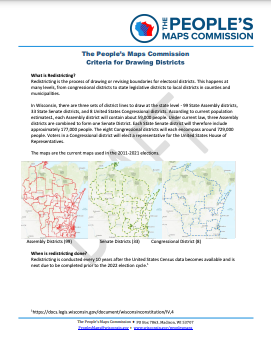The People's Maps Commission is committed to transparency and accountability. The hearings held in each of Wisconsin's eight congressional districts were part of the Commission's first phase of their work. This phase included hearing directly from Wisconsinites about how they have been impacted by redistricting, as well as ideas from community members on how to achieve fair maps in the state. Recordings of the People's Maps Commission's virtual hearings are available below, which includes the verbal testimony given by both experts and members of the public. Following the congressional district hearings, the Commission developed a set of criteria to guide their map drafting process. The Commission continued to accept public comment and submissions, including sample maps and Communities of Interest. After more than a year of accepting comment and listening to public input, the People’s Maps Commission initially released three sets of draft maps for public consideration. Following additional comment, an updated set of maps was released. The final maps are below.
People's Maps Commission Final Map Submissions
ASSEMBLY MAP
SENATE MAP
People's Maps Commission Hearings: By the Numbers
In less than six months, members of the People's Maps Commission:

Participated in more than 20 hours of public hearings

Heard feedback from nearly 2,000 Wisconsinites

Listened to individuals representing 68 counties and 321 municipalities

Learned from 18 redistricting experts from across the country and Wisconsin
Congressional District (CD) Hearings
CD 1 Hearing
CD 2 Hearing
CD 3 Hearing
CD 4 Hearing
CD 5 Hearing
CD 6 Hearing
CD 7 Hearing
CD 8 Hearing
Written Testimony
In addition to hearing the verbal testimony given in the hearings above, the People’s Maps Commission has been and will continue to accept written testimony throughout the process. In the interest of transparency, here are the written comments folks have provided. This spreadsheet is current as of Wednesday, April 28, and will be updated on a monthly basis.
Map Drawing Criteria
Upon completion of the initial Congressional district hearings, the Commissioners established their map drawing criteria, which included identifying "Communities of Interest" throughout the state. This is the memorandum outlining the criteria the People’s Maps Commission will be using to draw fair maps.
View the Memo